
上篇文章我们解决了Steam是否打折的问题,这篇文章我们要解决的是到底打折幅度有多少,这里我们就不能使用分类模型,而需要使用回归的模型了。

主要目标
在这个项目中,我将试图找出什么样的因素会影响Steam的折扣率并建立一个线性回归模型来预测折扣率。
数据
数据将直接从Steam的官方网站上获取。
https://store.steampowered.com/tags/en/Strategy/
我们使用Python编写抓取程序,使用的库包括:
“re”— regex”,用于模式查找。
“CSV”— 用于将数据写入.CSV文件中,使用pandas进行处理。
“requests”— 向Steam网站发送http/https请求
“BeautifulSoup”—用于查找html元素/标记。
当数据加载到Pandas中时,大概的显示如下所示:

我们训练模型的目标是:数据集中预测的目标是“折扣百分比”,DiscountPercentage
数据清洗
采集的原始数据包含许多我们不需要的东西:
一、 免费游戏,没有价格,包括演示和即将发布。
二、不打折的游戏。
三、非数值的数据
我们在把他们清洗的同时,还可以做一些特征工程。
在后面的章节中,我将介绍在建模和测试时所做的所有特性工程,但是对于基线模型,可以使用以下方式
添加一个“季节”栏,查看游戏发布的季节:
完成上述过程后,我们现在可以从dataframe中删除所有基于字符串的列:
这个过程还将把我们的结果从14806个和12个特征缩小到370个条目和7个特征。
不好的消息是这意味着由于样本量较小,该模型很容易出现误差。

数据分析
分析部分包括三个步骤:
- 数据探索分析(EDA)
- 特征工程(FE)
- 建模
一般工作流程如下所示:
EDA以找到的特征-目标关系(通过对图/热图、Lasso 系数等)
根据可用信息,进行特征工程(数学转换、装箱、获取虚拟条目
使用R方和/或其他指标(RMSE、MAE等)建模和评分
冲洗并重复以上步骤,直到尝试并用尽所有潜在的特征工程想法或达到可接受的评分分数(例如R方)。
# Plotting heat map as part of EDA
sns.heatmap(df.corr(),cmap="YlGnBu",annot=True)
plt.show()
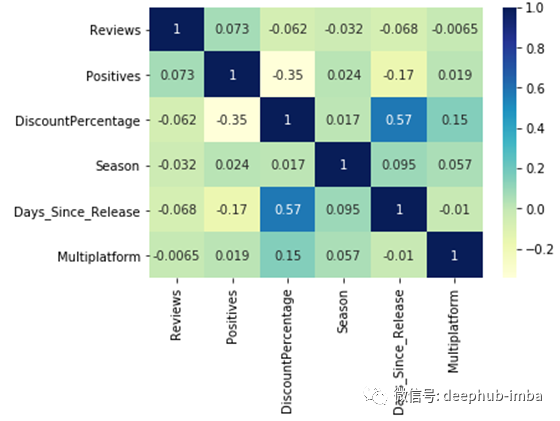
# A compiled function to automatically split data, make and score models. And showing you what's the most relevant features.
def RSquare(df, col):
X, y = df.drop(col,axis=1), df[col]
X, X_test, y, y_test = train_test_split(X, y, test_size=.2, random_state=10) #hold out 20% of the data for final testing
#this helps with the way kf will generate indices below
X, y = np.array(X), np.array(y)
kf = KFold(n_splits=5, shuffle=True, random_state = 50)
cv_lm_r2s, cv_lm_reg_r2s, cv_lm_poly_r2s, cv_lasso_r2s = [], [], [], [] #collect the validation results for both models
for train_ind, val_ind in kf.split(X,y):
X_train, y_train = X[train_ind], y[train_ind]
X_val, y_val = X[val_ind], y[val_ind]
#simple linear regression
lm = LinearRegression()
lm_reg = Ridge(alpha=1)
lm_poly = LinearRegression()
lm.fit(X_train, y_train)
cv_lm_r2s.append(lm.score(X_val, y_val))
#ridge with feature scaling
scaler = StandardScaler()
X_train_scaled = scaler.fit_transform(X_train)
X_val_scaled = scaler.transform(X_val)
lm_reg.fit(X_train_scaled, y_train)
cv_lm_reg_r2s.append(lm_reg.score(X_val_scaled, y_val))
poly = PolynomialFeatures(degree=2)
X_train_poly = poly.fit_transform(X_train)
X_val_poly = poly.fit_transform(X_val)
lm_poly.fit(X_train_poly, y_train)
cv_lm_poly_r2s.append(lm_poly.score(X_val_poly, y_val))
#Lasso
std = StandardScaler()
std.fit(X_train)
X_tr = std.transform(X_train)
X_te = std.transform(X_test)
X_val_lasso = std.transform(X_val)
alphavec = 10**np.linspace(-10,10,1000)
lasso_model = LassoCV(alphas = alphavec, cv=5)
lasso_model.fit(X_tr, y_train)
cv_lasso_r2s.append(lasso_model.score(X_val_lasso, y_val))
test_set_pred = lasso_model.predict(X_te)
column = df.drop(col,axis=1)
to_print = list(zip(column.columns, lasso_model.coef_))
pp = pprint.PrettyPrinter(indent = 1)
rms = sqrt(mean_squared_error(y_test, test_set_pred))
print('Simple regression scores: ', cv_lm_r2s, '\n')
print('Ridge scores: ', cv_lm_reg_r2s, '\n')
print('Poly scores: ', cv_lm_poly_r2s, '\n')
print('Lasso scores: ', cv_lasso_r2s, '\n')
print(f'Simple mean cv r^2: {np.mean(cv_lm_r2s):.3f} +- {np.std(cv_lm_r2s):.3f}')
print(f'Ridge mean cv r^2: {np.mean(cv_lm_reg_r2s):.3f} +- {np.std(cv_lm_reg_r2s):.3f}')
print(f'Poly mean cv r^2: {np.mean(cv_lm_poly_r2s):.3f} +- {np.std(cv_lm_poly_r2s):.3f}', '\n')
print('lasso_model.alpha_:', lasso_model.alpha_)
print(f'Lasso cv r^2: {r2_score(y_test, test_set_pred):.3f} +- {np.std(cv_lasso_r2s):.3f}', '\n')
print(f'MAE: {np.mean(np.abs(y_pred - y_true)) }', '\n')
print('RMSE:', rms, '\n')
print('Lasso Coef:')
pp.pprint (to_print)
先贴一些代码,后面做详细解释
第一次尝试:基本模型,删除评论少于30条的游戏
# Setting a floor limit of 30
df1 = df1[df1.Reviews > 30]
Best Model: Lasso
Score: 0.419 +- 0.073
第二次:“Reviews” & “OriginalPrice” 进行对数变换
df2.Reviews = np.log(df2.Reviews)
df2.OriginalPrice = df2.OriginalPrice.astype(float)
df2.OriginalPrice = np.log(df2.OriginalPrice)
Best Model: Lasso
Score: 0.437 +- 0.104
第三次:将mantag进行onehot编码

# Checking to make sure the dummies are separated correctly
pd.get_dummies(df3.Main_Tag).head(5)
# Adding dummy categories into the dataframe
df3 = pd.concat([df3, pd.get_dummies(df3.Main_Tag).astype(int)], axis = 1)
# Drop original string based column to avoid conflict in linear regression
df3.drop('Main_Tag', axis = 1, inplace=True)
Best Model: Lasso
Score: 0.330 +- 0.073
第四次:尝试把所有非数值数据都进行onehot编码
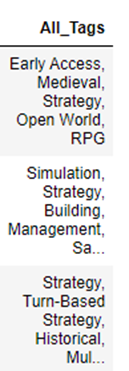
# we can get dummies for each tag listed separated by comma
split_tag = df4.All_Tags.astype(str).str.strip('[]').str.get_dummies(', ')
# Now merge the dummies into the data frame to start EDA
df4= pd.concat([df4, split_tag], axis=1)
# Remove any column that only has value of 0 as precaution
df4 = df4.loc[:, (df4 != 0).any(axis=0)]
Best Model: Lasso
Score: 0.359 +- 0.080
第五次:整合2和4次操作
# Dummy all top 5 tags
split_tag = df.All_Tags.astype(str).str.strip('[]').str.get_dummies(', ')
df5= pd.concat([df5, split_tag], axis=1)
# Log transform Review due to skewed pairplot graphs
df5['Log_Review'] = np.log(df5['Reviews'])
Best Model: Lasso
Score: 0.359 +- 0.080
看到结果后,发现与第4次得分完全相同,这意味着“评论”对折扣百分比绝对没有影响。所以这一步操作可以不做,对结果没有任何影响
第六次:对将“评论”和“发布后的天数”进行特殊处理
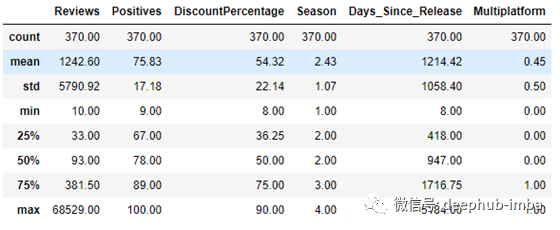
# Binning reviews (which is highly correlated with popularity) based on the above 75 percentile and 25 percentile
df6.loc[df6['Reviews'] < 33, 'low_pop'] = 1
df6.loc[(df6.Reviews >= 33) & (df6.Reviews < 381), 'mid_pop'] = 1
df6.loc[df6['Reviews'] >= 381, 'high_pop'] = 1
# Binning Days_Since_Release based on the above 75 percentile and 25 percentile
df6.loc[df6['Days_Since_Release'] < 418, 'new_game'] = 1
df6.loc[(df6.Days_Since_Release >= 418) & (df6.Days_Since_Release < 1716), 'established_game'] = 1
df6.loc[df6['Days_Since_Release'] >= 1716, 'old_game'] = 1
# Fill all the NaN's
df6.fillna(0, inplace = True)
# Drop the old columns to avoid multicolinearity
df6.drop(['Reviews', 'Days_Since_Release'], axis=1, inplace = True)
这两列被分成三个特征。
Best Model: Ridge
Score: 0.273 +- 0.044
第七次:拆分其他特征并删除不到30条评论的结果。

# Setting a floor threshold of 30 reivews for the data frame to remove some outliers
df7 = df7[df7.Reviews > 30]
# Binning based on 50%
df7.loc[df7['Reviews'] < 271, 'low_pop'] = 1
df7.loc[df7['Reviews'] >= 271, 'high_pop'] = 1
df7.loc[df7['Days_Since_Release'] < 1167, 'new_game'] = 1
df7.loc[df7['Days_Since_Release'] >= 1167, 'old_game'] = 1
# Fill all NaN's
df7.fillna(0, inplace= True)
# Drop old columns to avoid multicolinearity
df7.drop(['Reviews', 'Days_Since_Release'], axis=1, inplace = True)
Best Model: Lasso
Score: 0.313 +- 0.098
清洗总结:让我们从数据清理产生的一些统计数据开始:

现在,让我们看看影响折扣率的前两个特性是什么:

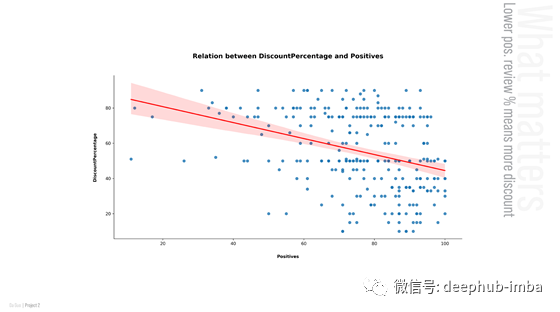
但是什么不影响折扣率呢?让我们看看不影响折扣率的前两个特性是什么:
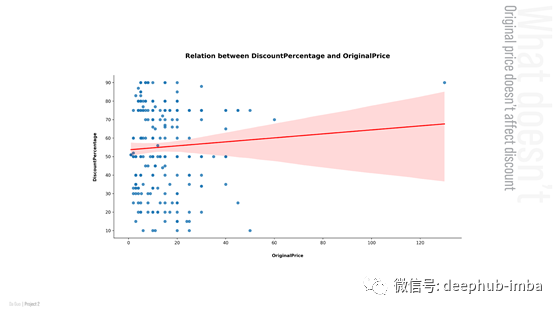
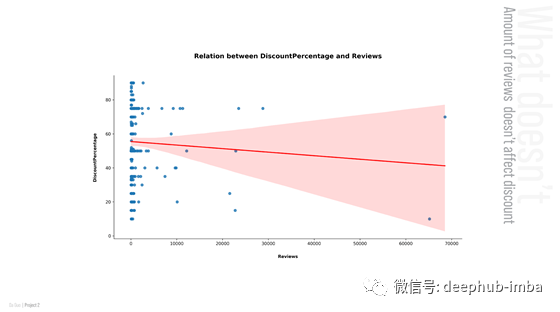
最好的模型实际上是误差最小的基线模型。
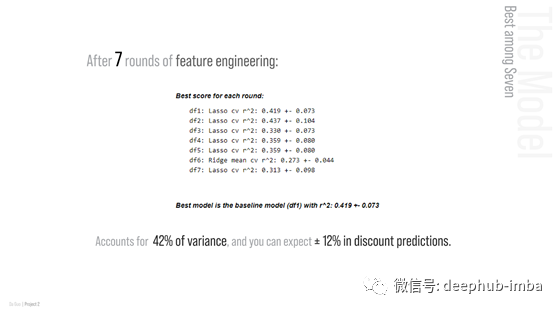
0.42的R方看起来并不是很好,但是这与Steam如何处理折扣有很大关系-因为只有出版商/开发商才有权对他们的游戏进行打折。
这意味着折扣率将在很大程度上取决于每个出版商/开发商的营销策略和他们的财务状况。虽然我希望将来情况会有所改善,但我目前无法收集到这样的数据。
用户案例
这个模型看起来好像没什么实际用处,其实它也有实际的意义——它对在线视频游戏转售商来说将特别有用。
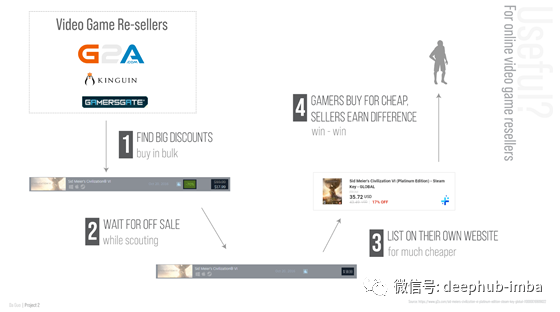
如上图所示,我的预测模型可以帮助他们预测下一个大折扣,这样他们就可以更好地分配资源,潜在地增加利润率。
本文作者:Da Guo
github项目地址:https://github.com/opophehu/LR_Steam
DeepHub
微信号 : deephub-imba
每日大数据和人工智能的重磅干货
大厂职位内推信息
长按识别二维码关注 ->
好看就点在看!********** **********